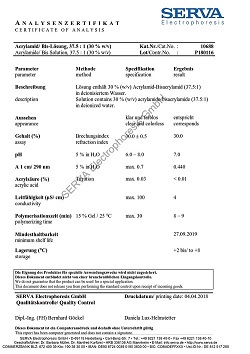TWEEN® 20
Tween 20 is a polyoxyethylene sorbitol ester containing approximately 20 units of ethylene oxide per unit of sorbitol. The fatty acid composition is heterogeneous with lauric acid as major component (40 - 60 %).
Tween 20 is of importance in immunological determination procedures. It effectively suppresses unspecific reactions between antibodies, antigens, and other molecules.
Tween 20 can also be used as a solubilizer in membrane chemistry and as an additive for cell culture media.
In thiophilic interaction chromatography, Tween 20 has proved effective in the elution of strongly adsorbed proteins
Other notable applications are e.g. turbidimetric determination of lipolytic enzymes and density gradient centrifugation of viruses.
TWEEN 20 is a registered trademark of the CRODA International Plc.
Synonyms: Polysorbate 20, Montanox 20, PEG (20) sorbitan monolaureate
CAS registry number: [9005-64-5]
Relative molecular mass (Mr): ca. 1200
Classification: Non-ionic surfactant
Literature specifications:
- Critical micellar concentration (CMC): 0.059 mM
- Cloud point (cp): 76 °C (3% in 1 N NaCl solution)
- Partial specific volume: 0.869 cm3/g
- Hydrophilic-lipophilic balance (HLB): 16.7
Bibliography
Immunological Determination Procedures
Hunger, H.D., Flachmeier, C., Schmidt, G., Behrendt, G. a. Coutelle, C. (1988) A protein-free blocking system for the covalently binding matrix cyanuric chloride-activated paper in immunological procedures. J. Biochem. Biophys. Methods 17, 43-50
Ming, C.H. a. Fan, Y.S. (1988) Enhancement of anti-phospholipid antibody activity by Tween 20. J. Immunol. Methods 109, 253-5.
Mohammad, K. a. Esen, A. (1989) A blocking agent and a blocking step are not needed in ELISA, immunostaining dot-blots and Western blots. Immunol. Methods 117, 141-5.
Thean, E.T. a. Toh, B.H. (1989) Western immuno‑blotting: temperature-dependent reduction in background staining. Anal. Biochem. 177, 256-8.
Tovey, E.R., Ford, S.A. a. Baldo, B.A. (1989) Enhanced immunodetection of blotted house dust mite protein allergens on nitrocellulose following blocking with Tween 20. Electrophoresis 10, 243-9.
Tsang, V.C.W. a. Wilkins,P.P. (1991) Optimum dissociation condition for immunoaffinity and preferential isolation of antibodies with high specific activity. J. Immunol. Methods 138, 291-9.
Mushens, R.E. et al. (1993) Quantitation of monoclonal antibodies by ELISA: The use of purified mouse IgG and mouse IgM monoclonal antibodies as standards in a quantitative ELISA measuring monoclonal antibodies produced by cell culture. J.Immunol.. Methods 162, 77-83.
Cheng, H.M. (1996) Tween 20 selectively enhances naturally occurring anticardiolipin antibody binding in ELISA procedures. J. Immunol. Methods 191, 87-91.
Huttner, H.B. et al. (2008) The stem cell marker prominin-1/CD133 on membrane particles in human cerebrospinal fluid offers novel approaches for studying central nervous system disease. Stem Cells 26, 698-705.
Solubilization and Characterization of Enzymes
Lund, S., Orlowski, S., De Foresta, B., Champed, P., Le Maire a. M., Moeller, J. V. (1989) Detergent structure and associated lipid as determinants in the stabilization of solubilized Ca2+-ATPase from sarcoplasmic reticulum. J. Biol. Chem. 264, 4907-15.
Stocklein, W. et al. (1993) Purification and properties of a lipase from Penicillium expansum. Biochim. Biophys. Acta 1168, 181-9.
Schilstra, M.J. et al. (1994) Effect of non-ionic detergents on lipoxygenase catalysis. Lipids 29, 225-31
Mitsutake, S. et al. (2001) Purification, characterization, molecular cloning, and subcellular distribution of neutral ceramidase of rat kidney. J. Biol. Chem. 276, 26249-59.
Cell Culture Techniques
Baykusheva, S. a. Ilieva, K. (1988) Sporulation and extracellular alkaline protease activity of Bacillus subtilis 168 grown in the presence of Tween. Biotekhnol. Biotekh. 4, 22-4.
Gomez-Lopez, A. et al. (2005) Analysis of the influence of Tween concentration, inoculum size, assay medium, and reading time on susceptibility testing of Aspergillus spp. J. Clin. Microbiol.43, 1251-5.
Chromatographic and Electrophoretic Separations
El Rassi, Z. (1989) High performance liquid chromatography of proteins with silica-bound sulfone-thioether functions. BioChromatography 4, 184-90.
Matsubara, N. et al. (1995) Separation of eleven angiotensin II analogs by capillary electrophoresis with a nonionic surfactant in acidic media. Electrophoresis 16, 580-3.
Further Applications
Watanabe, T., Kitabatake, N. a. Doi, E. (1988) Protective effects of nonionic surfactants against denaturation of rabbit skeletal myosin by freezing and thawing. Agric. Biol. Chem. 52, 2517-23.
Boeye, A. a. De Rees, A. (1989) Wall effects in sucrose density gradient centrifugation of viruses. Arch. Virol. 107, 77-84.
Takahashi, T., Mitsuda, T. a. Okuda, K. (1989) An alternative nonradioactive method for labeling DNA using biotin. Anal. Biochem. 179, 77-85.
Von Tigerstrom, R. G. a. Stelmaschuk, S. (1989) The use of Tween 20 in a sensitive turbidimetric assay of lipolytic enzymes. Can. J. Micro-biol. 35, 511-4.
Holloway, P.J. et al. (1992) Effects of some non-ionic polyoxyethylene surfactants on uptake of ethirimol and diclobutrazol from suspension formulations applied to wheat leaves. Pesticide Science 34, 109-18.
Knoche, M. a. Bukovac, M.J. (1992) Surfactants influence foliar absorption of gibberellic acid by sour cherry leaves. J. Amer. Soc. Hort. Sci. 117, 80-4.
Neu, T.R. (1996) Significance of bacterial surface-active compounds in interaction of bacteria with interfaces. Microbiol. Reviews, March 1996, 151-66.
Das, A. et al. (1999) Retinal neovascularization is suppressed with a matrix metalloproteinase inhibitor. Arch. Ophthalmol. 117, 498-503.
Slawecki, R.A. et al. (2002) Novel fungitoxicity assays for inhibition of germination-associated adhesion of Botrytis cinerea and Puccinia recondite spores. Appl. Environ. Microbiol. 68, 597-601.
Schuck, S. et al. (2003) Resistance of cell membranes to different detergents. PNAS 100, 5795-800.
Yoshimura, S.H. et al. (2011) Fluorescence labeling of carbon nanotubes and visualization of a nanotube-protein hybrid under fluorescence microscope. Biomacromolecules 12, 1200-4.






